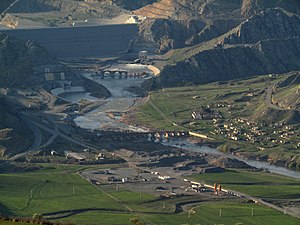胡达费林桥
| 胡达费林桥 | |
|---|---|
| پل خداآفرین(波斯文) Xudafərin körpüsü(阿塞拜疆文) Խուդաֆերինի կամուրջ(亞美尼亞文) | |
 | |
| 坐标 | 39°09′00″N 46°56′30″E / 39.15000°N 46.94167°E |
| 跨越 | 阿拉斯河 |
| 地图 | |
 | |
胡达费林桥,位于高加索地区阿拉斯河上的两座建于中世纪的联拱桥。胡达费林桥分为相互独立的两座,均处于胡达费林大坝下游不远处,两桥相距约800米,下游的东桥仍可以使用,而上游的西桥已经毁坏。两桥均呈东北-西南方向,所在河段为伊朗与阿塞拜疆两国的国界,北侧属于阿塞拜疆杰布拉伊尔区,距离最近的村庄为胡达费林村;南侧为伊朗东阿塞拜疆省的胡达费林县,距离最近的村庄为萨里贾卢村。
结构
[编辑]
东桥共有15个拱洞,长约200米,宽4.5米,距河面的最大高度为10米,由鹅卵石和烧制方砖建成,而且使用了大量的花岗岩。[1]东桥最大的桥洞的跨度为8.70米,最小的也有5.80米。
西桥原有11个拱洞,长约130米,宽6米,距河面的最大高度为12米,现仅存中间的三个半圆形的拱洞,故又称为“断桥”("synyg kyorpju"),该桥由石灰岩质的石砖砌成。[1]
历史
[编辑]
14世纪波斯历史学家哈马达拉·穆斯陶菲·加兹维尼认为胡达费林桥始建于伊斯兰历15年(公元637年),由先知穆罕默德的朋友伯克尔·本·阿卜杜拉建造。[2]:137此后曾经历了多次的维修和重建。俄罗斯东方学者弗拉基米尔·米诺尔斯基则认为,胡达费林桥建于11世纪初沙达德王朝埃米尔法德勒·本·穆罕默德在位期间。[3]
但现代科学家认为,实际的建造时间还要晚一些,东桥建造于12世纪的伊尔代尼兹王朝时期,西桥重建于13世纪的伊尔汗国时期[2]:137。胡达费林桥曾多次毁于洪水破坏,东桥最近的一次大修是在18世纪。对于为何在东桥运作时重建西桥,可能是与伊尔汗国为应对与金帐汗国的战事,而调遣大量军队通过胡达费林前往北方有关。[1]
20世纪初,为阻断南北阿塞拜疆之间的联系,苏联和伊朗共同决定毁掉了西桥的大部分,仅余中间3个桥洞。[2]:136从此,西桥在当地有了第二个名字——“断桥”(Sınıq körpü)。
胡达费林桥处在古代丝绸之路上,曾是当地的交通要冲,不仅往来商旅,很多军队调动和民族迁徙也都途径这里。[4][1]
图集
[编辑]-
阿塞拜疆邮票上的西桥
-
阿塞拜疆邮票上的西桥
-
阿尔察赫10德拉姆纸币上的西桥
-
阿塞拜疆邮票上的东桥
参考
[编辑]- ^ 1.0 1.1 1.2 1.3 Khudaferin Bridges, Azerbaijan. Advantour. [2016-09-06]. (原始内容存档于2019-12-07).
- ^ 2.0 2.1 2.2 C. Qiyasi – Nizami dövrünün memarlıq abidələri(尼扎米时代的建筑), Bakı, İşıq, 1991
- ^ V. MINORSKY. Studies in Caucasian history. 1953. "The building of a bridge on the Araxes in 421/1030 is a hint at the extent of Fadl's dominions in the south. The bridge was a symbol either of his solicitude for the development of trade, or more probably of his designs against Azarbayjan. As explained in note 8 (to the text), I take it as more probable that Fadl's bridge was that of Khudafarm which connects the central portions of the two mountainous tracts: to the north of the Araxes, the present-day Soviet Qara-bagh; and to the south of this river, the Persian Qaraja-dagh. According to the Nuzhat al-Qulub, p. 84, one of the districts of Qaraja-dagh bore the name *Gildn-i Fadlun and consisted of so villages. This suggests that Fadl had expanded to the southern bank of the Araxes. From this region he could threaten the Rawwadis whose central axis was on the line Ahar-Tabriz. It is likely that Fadl was attracted by the eastern Azarbayjan, then lying masterless. An ode of Qatran in Kasravi, II, 93, indicates that the Rawwadis also had ambitions in the direction of Mughan. For all these reasons a bridge on the Araxes (at Khudafarin?) was a useful convenience for Fadl. "
- ^ Худаферинские мосты (Xudafərin körpüləri) (rusca). [2016-09-07]. (原始内容存档于2020-10-19).





